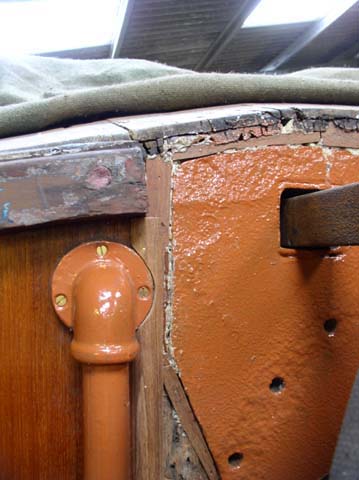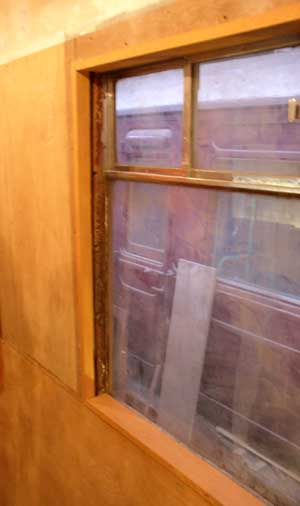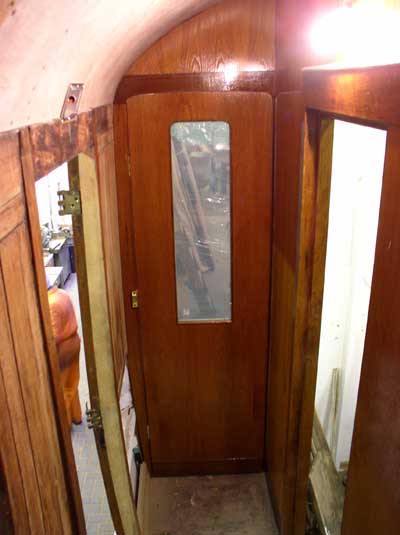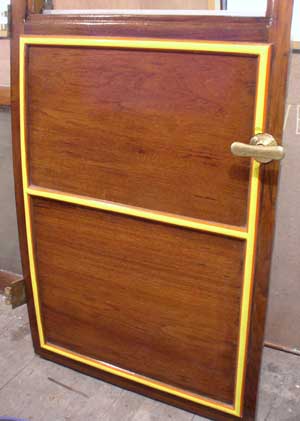
All the mouldings having been fitted to the joints on the sides of the coach, attention was turned to the ends and the gangways. The hood was removed from both gangways and the "bellows" canvas detached from the wood (not from the gangway). This allowed access to clean up the difficult to get at bits of the wood surface and also allowed Jim Ormiston access with his needle gun to remove all the corrosion from the top gangway mounting plate. This was then given a coat of primer (or two) and looks MUCH better. The damaged wood between the mounting plate and the roof boards was replaced to give a great deal more integrity to the area below the roof board ends. The vertical mouldings covering the joints on the end panels have now all been fitted and gold-sized. George (in particular) has continued the task of sealing the half-round mouldings along both sides of the coach with brown flexible filler applied with a mastic gun, then wiped off with a wet rag. Hopefully this will prevent moisure getting behind these mouldings and thus behind the main body panels.


New main body lights were sourced to replace the missing ones in the corridor. These were fitted in October 2005. All the external window mouldings have been fixed in place (temporarily at least) to support the body lights from the outside. Window sills, lintels and side (tapered) pieces have been manufactured and put in place (again temporarily) to support the windows on the inside. The sills still need the water drain channels routered in and the drain ferrules fitted. In order to install the internal parts, the plywood cladding the walls on the inside of the saloon had to be removed, shaved down to the correct size to leave an aperture just larger than the window (to allow Rexine to be folded round the edges), then screwed back in place. All the internal pieces were fitted together and left in the window apertures. The rounded moulding on the inside of the window surround still has to be formed, but this will be left nearer the time when the Rexine is fitted. The two windows behind the bar don't have blind guides so they require a different pattern of mouldings for the interior. The sills and lintels are more or less the same as the other windows, but the vertical trims are very different.
As winter 2005 approached, the internal saloon doors were glazed and fitted so a modicum of heat might be retained inside the coach. In this relatively kind environment activities such as varnishing were still possible - no way was any varnishing going on to the exterior of the coach as the temperature in the shed was close to zero. Work on re-assembling the exterior doors was also in progress at this time. The doors were temporarily re-hung in order to check the line-up of the horizontal half-round mouldings with the existing mouldings on the coach sides. Internally, the tongue and groove panelling, door knobs, drop-lights, locks etc. were refurbished and fitted in place.


Dave Simpson started (December 2005) a monumental task - that of lining out the coach. He started on the corridor door (something small and therefore easy to gain a sense of achievement) which was stored inside the (gently heated) coach saloon. After the first 3 coats of varnish, the lining is applied to the half-round mouldings (see photo). A wide stripe of vermillion is applied first, then two coats of a thinner line of primrose. The lining of the lower body panels is the same as the door, but lining on the vertical mouldings on the upper half of the coach has a very fancy arrowhead at top and bottom. Many coats of varnish will be applied to the whole exterior surface post-lining. Only another 600 feet (or so) of lining to go!